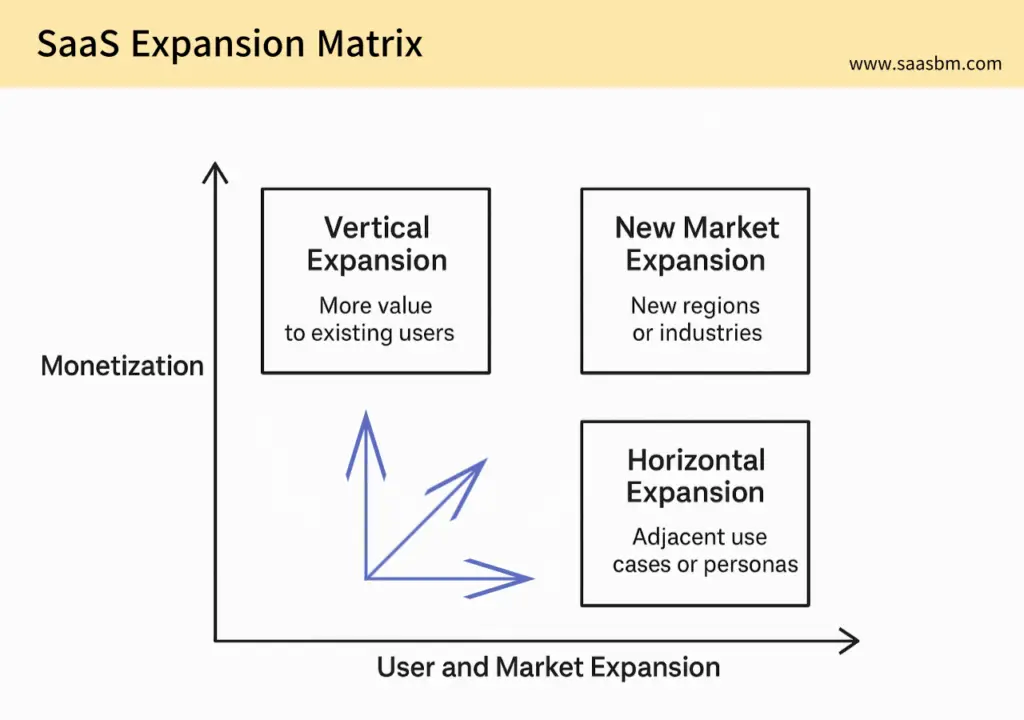Introduction
“Should we add new features or target a new market?”
“Do we go deeper with our current users, or reach new ones?”
These are common — and critical — questions SaaS startups face once early traction is achieved.
Growth isn’t just about moving fast — it’s about moving in the right direction.
That’s why the SaaS Expansion Matrix exists.
It’s a simple but powerful strategic framework that helps SaaS founders choose how to expand — with clarity and intention.
What Is the SaaS Expansion Matrix?
The SaaS Expansion Matrix outlines three core directions of strategic growth:
- Vertical Expansion
- Horizontal Expansion
- New Market Expansion
Each direction focuses on a different dimension of scale — whether it’s deeper monetization, broader user reach, or tapping into untapped territories.
The matrix gives you a structured way to prioritize and allocate resources for maximum impact.

The Three Types of SaaS Expansion
✅ Vertical Expansion
- Definition: Offer more value to your existing customers
- Examples:
- Upselling premium features to current users
- Offering admin controls, analytics, or security add-ons
- When to Use:
- High user retention, but flat revenue growth
- Strong product-market fit within a single persona
- Goal: Boost ARPU (Average Revenue Per User)
✅ Horizontal Expansion
- Definition: Expand into adjacent use cases or personas
- Examples:
- A design tool adding use cases for developers
- A CRM offering HR or finance team templates
- When to Use:
- Core product solves universal problems
- Early signs of use by multiple roles or industries
- Goal: Grow total active user base
✅ New Market Expansion
- Definition: Enter a new region, industry, or business size
- Examples:
- Launching in APAC after gaining traction in North America
- Targeting enterprise after starting with SMBs
- When to Use:
- Saturation in current market
- Competitive advantage in underserved geographies or verticals
- Goal: Diversify revenue, reduce dependence on a single market
Real-World Example: “Schedly” – A SaaS Calendar for Creative Teams
Let’s say you run Schedly, a smart calendar tool built for creative teams.
Here’s how the Expansion Matrix might apply:
| Expansion Type | Strategy Example |
|---|---|
| Vertical | Add project analytics, client dashboards for existing users |
| Horizontal | Launch features for marketing, sales, and support teams |
| New Market | Localize for Japan and Korea, integrate with local tools |
Schedly doesn’t just grow by “adding features.” It grows by aligning each expansion strategy with user behavior and market opportunity.
Summary: Choose Your Growth Direction
| Expansion Type | Core Question | Strategic Purpose |
|---|---|---|
| Vertical Expansion | “Can we offer more to existing users?” | Increase ARPU, deepen value |
| Horizontal Expansion | “Can we serve adjacent use cases?” | Expand user base |
| New Market Expansion | “Can we win in new territories?” | Diversify and de-risk |
Final Thoughts
SaaS growth isn’t just about adding — it’s about aligning.
If you don’t know where you’re going, you’ll waste time, money, and morale.
The SaaS Expansion Matrix keeps you grounded and focused.
It forces your team to ask: “Which move makes the most sense, right now?”
So before launching a new feature or investing in international ads, gather your team and ask:
“Are we growing vertically, horizontally, or into a new market?”
The answer will help you scale faster — and smarter.

No comment yet, add your voice below!